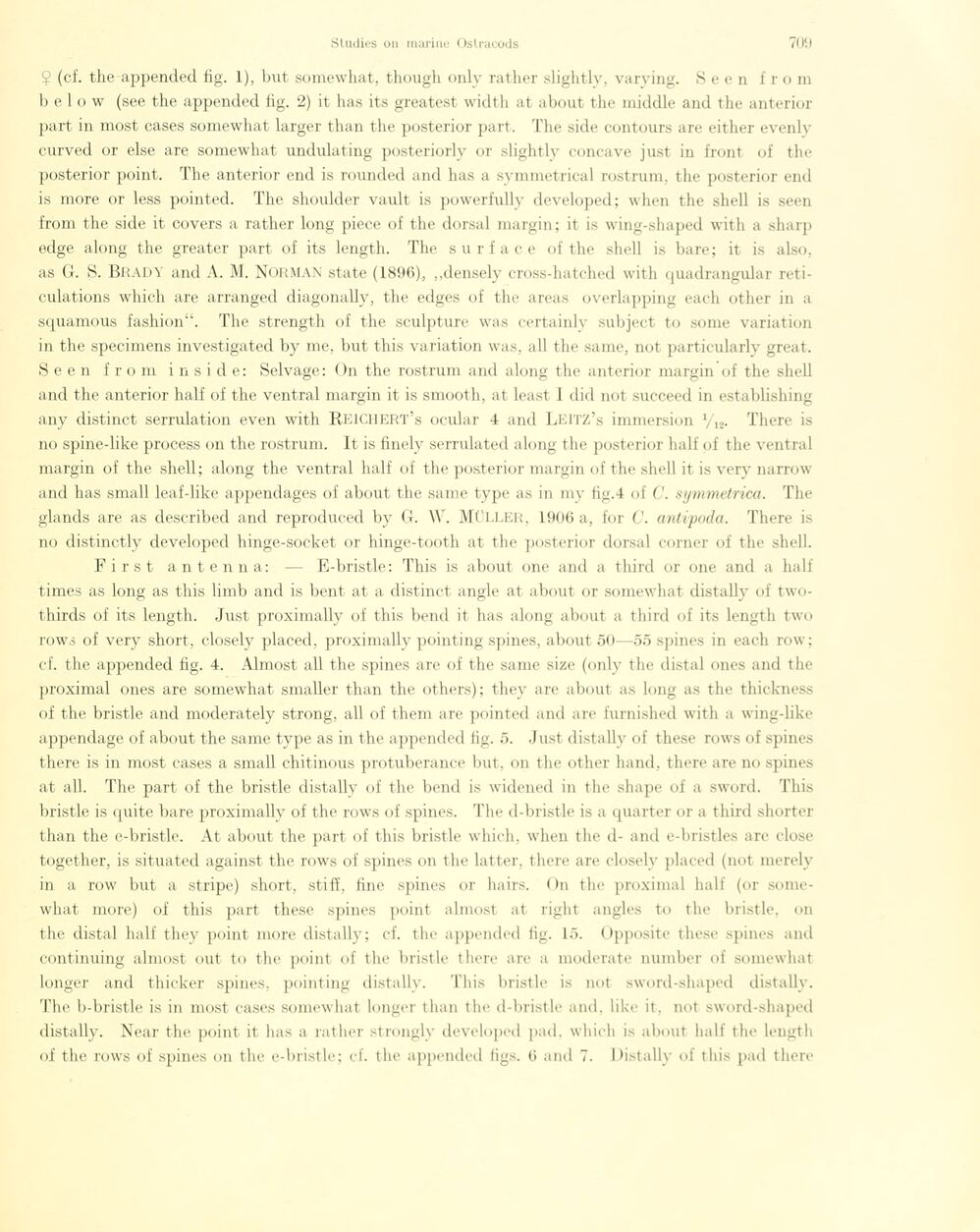
Full resolution (JPEG) - On this page / på denna sida - Sidor ...

<< prev. page << föreg. sida << >> nästa sida >> next page >>
Below is the raw OCR text
from the above scanned image.
Do you see an error? Proofread the page now!
Här nedan syns maskintolkade texten från faksimilbilden ovan.
Ser du något fel? Korrekturläs sidan nu!
This page has never been proofread. / Denna sida har aldrig korrekturlästs.
$ (cf. the appended fig. 1), but somewhat, though only rather slightly, varving. 8 e e n f r o m
b e 1 o w (see the appended fig. 2) it has its greatest width at about the middle and the anterior
part in most cases somewhat larger than the posterior part. The side contours are either evenlv
curved or else are somewhat undulating posteriorly or slightly concave just in front of the
posterior point. The anterior end is rounded and has a symmetrical rostrum, the posterior end
is more or less pointed. The shoulder vault is powerfully developed; when the shell is seen
from the side it covers a rather long piece of the dorsal margin; it is wing-shaped with a sharp
edge along the greater part of its length. The surface of the shell is bare; it is also,
as G. S. Brady and A. M. Norman State (1896)., ,,densely cross-hatched with quadrangular
réticulations which are arranged diagonally, the edges of the areas overlapping each other in a
squamous fashion“. The strength of the sculpture was certainly subject to some variation
in the specimens investigated by me, but this variation was, all the same, not particularly great.
Seen from inside: Selvage: On the rostrum and along the anterior margin of the shell
and the anterior half of the ventral margin it is smooth, at least 1 did not succeed in establishing
any distinct serrulation even with REICHERT’s ocular 4 and LEITZ’s immersion y12. There is
no spine-like process on the rostrum. It is finely serrulated along the posterior half of the ventral
margin of the shell; along the ventral half of the posterior margin of the shell it is very narrow
and has small leaf-like appendages of about the same type as in my fig.4 of C. symmetrica. The
glands are as described and reproduced by G. W. Müller, 1906 a, for C. antipoda. There is
no distinctly developed hinge-socket or hinge-tooth at the posterior dorsal corner of the shell.
First antenna: — E-bristle: This is about one and a third or one and a half
times as long as this limb and is bent at a distinct angle at about or somewhat distally of
two-thirds of its length. Just proximally of this bend it has along about a third of its length two
rows of very short, closely placed, proximally pointing spines, about 50—55 spines in each row;
cf. the appended fig. 4. Almost all the spines are of the same size (only the distal ones and the
proximal ones are somewhat smaller than the others); they are about as long as the thickness
of the bristle and moderately strong, all of them are pointed and are furnished with a wing-like
appendage of about the same type as in the appended fig. 5. Just distally of these rows of spines
there is in most cases a small chitinous protubérance but, on the other hand, there are no spines
at ail. The part of the bristle distally of the bend is widened in the shape of a sword. This
bristle is quite bare proximally of the rows of spines. The d-bristle is a quarter or a third shorter
than the e-bristle. At about the part of this bristle which, when the d- and e-bristles are close
together, is situated against the rows of spines on the latter, there are closely placed (not merely
in a row but a stripe) short, stift’, fine spines or hairs. On the proximal half (or
somewhat more) of this part these spines point almost at right angles to the bristle, on
the distal half they point more distally; cf. the appended fig. 15. Opposite these spines and
continuing almost out to the point of the bristle there are a moderate number of somewhat
longer and thicker spines, pointing distally. This bristle is not sword-shaped distally.
The b-bristle is in most cases somewhat longer than the d-bristle and. like it, not sword-shaped
distally. Near the point it lias a rather strongly developed pad, which is about half the length
of the rows of spines on the e-bristle; cf. the appended figs. 6 and 7. Distally of this pad there
<< prev. page << föreg. sida << >> nästa sida >> next page >>